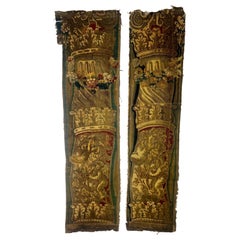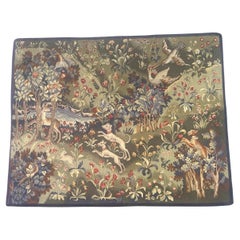Tapestries
21st Century and Contemporary American Modern Tapestries
Wool, Cotton
19th Century Asian Antique Tapestries
Fabric, Acrylic, Beads
18th Century French Baroque Antique Tapestries
Wool
1960s Egyptian Vintage Tapestries
Wool, Cotton
21st Century and Contemporary American Modern Tapestries
Cotton
Early 20th Century French Aubusson Tapestries
Wool, Silk
Mid-20th Century French Mid-Century Modern Tapestries
Wool
20th Century Indian Tapestries
Textile
19th Century French Antique Tapestries
Tapestry, Wood
2010s American Organic Modern Tapestries
Leather, Sheepskin, Felt, Hardwood
Mid-20th Century Egyptian Egyptian Tapestries
Wool
17th Century Belgian Baroque Antique Tapestries
Tapestry
2010s Turkish Modern Tapestries
Metal
Mid-20th Century Italian Renaissance Tapestries
Silk
Early 20th Century French Moorish Tapestries
Fabric
Early 20th Century Moroccan Moorish Tapestries
Silk
Mid-20th Century Congolese Tribal Tapestries
Raffia
1960s French Vintage Tapestries
Wool
Late 20th Century Congolese Tribal Tapestries
Natural Fiber
18th Century French Baroque Antique Tapestries
Wool, Silk
2010s Italian Tapestries
Textile
Early 20th Century Israeli Other Tapestries
Fabric
Mid-20th Century Swedish Scandinavian Modern Tapestries
Oak, Linen
17th Century Unknown Other Antique Tapestries
Wool, Cotton
2010s Indian Modern Tapestries
Wool
Mid-18th Century French Aubusson Antique Tapestries
Wool, Silk
15th Century and Earlier Peruvian Pre-Columbian Antique Tapestries
Textile, Linen
Early 20th Century French Tapestries
Wool, Silk
1970s Indian Agra Vintage Tapestries
Silk
Late 19th Century Uzbek Suzani Antique Tapestries
Cotton, Silk
17th Century French Baroque Antique Tapestries
Wool, Silk
Mid-20th Century European Mid-Century Modern Tapestries
Metal
Late 17th Century French Aubusson Antique Tapestries
Wool
Mid-20th Century French Aubusson Tapestries
Wool, Cotton, Acrylic
1950s French Mid-Century Modern Vintage Tapestries
Wool
19th Century Italian Renaissance Antique Tapestries
Ceramic
Early 20th Century Congolese Tribal Tapestries
Natural Fiber
1730s Antique Tapestries
Silk
Early 20th Century French Aubusson Tapestries
Wool, Silk
1820s Chinese Antique Tapestries
Silk
1970s Argentine Modern Vintage Tapestries
Wool
Early 1800s Japanese Japonisme Antique Tapestries
Fabric, Silk
Mid-20th Century Ivorian Tribal Tapestries
Raffia
Late 19th Century French Napoleon III Antique Tapestries
Silk
Late 20th Century Brazilian Mid-Century Modern Tapestries
Textile
1990s Italian Post-Modern Tapestries
Fabric
1960s American Mid-Century Modern Vintage Tapestries
Natural Fiber
Late 19th Century Indian Agra Antique Tapestries
Linen, Silk, Sequins
17th Century French Antique Tapestries
Wool, Silk
Mid-20th Century Burmese Other Tapestries
Silk
Early 1900s French Romantic Antique Tapestries
Silk, Wood
1970s Egyptian Mid-Century Modern Vintage Tapestries
Wool
Late 20th Century French Aubusson Tapestries
Wool, Cotton, Acrylic
1970s French Vintage Tapestries
Wool
1810s English Antique Tapestries
Linen, Silk
1930s Swedish Scandinavian Modern Vintage Tapestries
Wool, Linen, Pine
Early 19th Century French French Provincial Antique Tapestries
Wool
Early 20th Century Persian Kashan Tapestries
Wool
1720s French Aubusson Antique Tapestries
Wool, Silk
1940s American Baroque Revival Vintage Tapestries
Cotton
Shop Vintage Tapestries on 1stDibs
Whether you hang them behind your bed as a dazzling alternative to a headboard or over the sofa as a large-scale focal point in the living room, vintage tapestries can introduce an array of textures and colors to any space in your home.
Woven wall hangings haven’t consistently enjoyed the popularity or earned the highbrow status that other types of wall decorations have over the years, at least not since the 1970s, which was somewhat of a heyday for tapestries. Today, however, these tactile works of art are seeing a renaissance, as modern weavers are forging new paths in the medium while the demand for antique and vintage tapestries continues to grow.
“We are drawn to texture in environments, and we see tapestries as a subtle layer of soft ornament,” says Lauren Larson of the New York design duo Material Lust. Indeed, and a lot of opportunity comes along when decorating with this distinctive brand of soft ornament.
Think of wall hangings as paintings created by hand with fabric instead of oil or watercolors. If you’re not simply securing your treasure to a wall with nails, pushpins or Velcro, tapestries can be stretched over a frame, used to create a canopy in a cozy living-room corner, hung from a rod or placed inside a shadowbox. And because this kind of textile art is hundreds of years old, options abound with respect to subjects and designs.
For richly detailed depictions of landscapes and garden scenes, look to antique Chinese tapestries and Japanese tapestries. Aubusson tapestries are ornate wall hangings manufactured in central France that are also characterized by romantic portrayals of nature. For weavers of mid-century modern tapestries, as well as those working in textile arts today, the styles and subject matter are too numerous to mention, with artists exploring experimental shapes, bold colors and provocative abstract designs.
Antique, new and vintage tapestries can make a room feel warm and welcoming — find yours on 1stDibs now.



